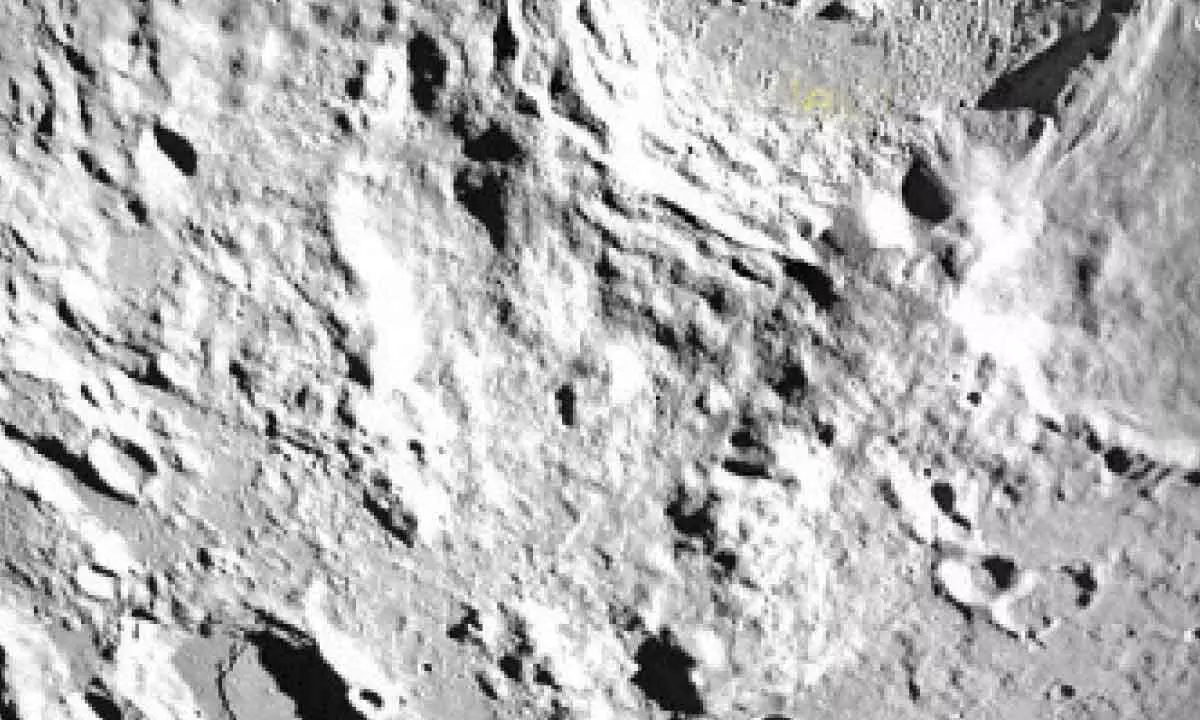Live
- 10 career opportunities with a public policy degree
- TG Medical Council cracks whip on fake doctors
- TTD takes up mammoth waste management exercise
- Celebrating the power of communication
- Standing at work can actually be detrimental to BP
- Adani US bribery case reaches SC
- Prez, PM to address special event to mark Constitution Day
- I owe every film of mine to Vijay Sethupathi: Eashvar Karthic
- Achoo! City faces spike in flu, cold, cough cases
- CPM demands TTD to allocate Rs 100 cr every year for Tirupati development
Just In
Bengaluru: 'Welcome, buddy!' — Chandrayaan-2 orbiter chats with Lander


Shoots images of Moon's far side area
Bengaluru : ISRO on Monday said the Chandrayaan-3 mission's lander module has established communication with the Chandrayaan-2 orbiter, and released images of the lunar far side area captured by the Lander Hazard Detection and Avoidance Camera (LHDAC). The lander, along with a rover accommodated inside it, of India's third lunar exploration mission is expected to touch down on the surface of the Moon around 6.04 pm on Wednesday, according to the national space agency.
"‘Welcome, buddy!' Ch-2 orbiter formally welcomed Ch-3 LM. Two-way communication between the two is established. MOX has now more routes to reach the LM," ISRO said in a post on 'X'. As per specifications, in addition to Chandrayaan-2 orbiter, the lander of Chandrayaan-3 has the capability to communicate with the Indian Deep Space Network (IDSN), a network of large antennas and communication facilities operated by ISRO to support the interplanetary spacecraft missions of India, at Byalalu in Ramanagara district, and the 26 kg rover.
The MOX (Mission Operations Complex) is located at ISRO Telemetry, Tracking and Command Network (ISTRAC) here. ISRO also said, in an update, that the live telecast of the landing event will begin at 5.20 pm on Wednesday. The Chandrayaan-2 spacecraft comprising orbiter, lander and rover was launched in 2019. The lander with rover in its belly crashed into the Moon's surface, failing in its mission on soft-landing.
ISRO said in 2019 that due to the precise launch and orbital manoeuvres, the mission life of the orbiter has increased to seven years. The LHDAC that assists in locating a safe landing area -- without boulders or deep trenches -- during the descent is developed by Ahmedabad-based Space Applications Centre (SAC), a major research and development centre of ISRO.
According to the space agency, several advanced technologies are present in the lander such as LHDAC to achieve the mission objectives of Chandrayaan-3. Chandrayaan-3, launched on July 14, is a follow-on mission to Chandrayaan-2 to demonstrate end-to-end capability in safe landing and roving on the lunar surface.
The mission life of the lander and rover is one lunar day or 14 earth days. Referring to the expected touchdown, former ISRO chairman G Madhavan Nair kept his fingers crossed and said it’s a very complex manoeuvre and one has to be cautious as all systems have to work in unison for its success. Nair, who headed the space agency when Chandrayaan-1 mission was launched in 2008, said a successful landing would herald a big beginning for ISRO’s next phase of planetary exploration.
“It’s a very complex manoeuvre. We narrowly missed it (soft-landing on the Moon in Chandrayaan-2 mission) in the last two kilometres (above the lunar surface),” he said. “So, there are a host of things that have to work in unison...thrusters, sensors, altimeters, computer software and all those things. Any glitch happening anywhere...we can be in trouble,” Nair said.

© 2024 Hyderabad Media House Limited/The Hans India. All rights reserved. Powered by hocalwire.com






